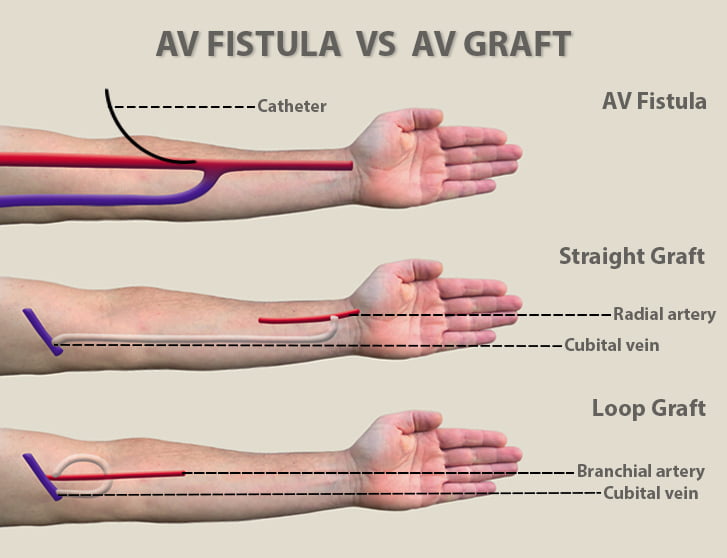
With all the decisions you have to make and the disruptions to your life when you learn that you need to undergo kidney dialysis, the last thing you need to worry about is which type of access port you need. Instead, rely on the experience and expertise of Dr. George Bolotin at the Astra Vein Treatment Center in Brooklyn, NY and Bronx, NY. He provides you with the best recommendation for your particular situation, which can make your treatments easier and faster. Dr. Bolotin is an Interventional Radiologist, with a focus on vascular conditions, so he’s the perfect specialist for this decision. Call now for a consultation.
AV stands for arteriovenous, which means affecting or relating to a vein or an artery. AV fistula and AV graft are surgical vascular access options that you need before you begin regular hemodialysis treatments. AV fistula, used for long-term dialysis, connects a selected artery and a vein directly. An AV graft connects the artery and vein indirectly, through a tube and graft.
Hemodialysis is a kidney treatment in which blood goes into an external machine called a dialyzer. The dialyzer filters out wastes and extra fluid from your blood and pumps the blood back into your body. For effective hemodialysis, the dialyzer requires large amounts of blood. AV fistula and AV graft placement allow large amounts of blood to flow continuously and smoothly during dialysis.
Dr. George Bolotin, an Interventional Radiologist who specializes in vascular conditions, founded the Astra Vein Treatment Center in Brooklyn, New York and and Bronx, New York. He dissects the AV fistula vs. AV graft debate. Rely on his expertise to provide you with the best dialysis port before you begin your life-saving treatments.

Your vein specialist spends considerable time examining you and your blood vessels before making a recommendation. In conjunction with your nephrologist, Dr. Bolotin provides you with the best advice when choosing between a dialysis graft vs. fistula, both of which are effective access options. Points to consider include:
To decide between an AV fistula vs. AV graft for your vascular access, doctors consider these pros and and cons and what your particular needs are at the time. The decision determines which procedure is best for you and your needs.
An arteriovenous fistula (AV fistula) is a surgical access procedure to connect an artery and a vein directly. The higher flow and pressure of blood in the vein is necessary for adequate hemodialysis treatment. You can use an AV fistula for long-term dialysis. The procedure involves:
Vascular access offers a lifeline for hemodialysis treatments. When AV fistula placement is done properly, you get a long-term vascular access for more effective management of end-stage renal disease. When you have to wait for an organ donor for a transplant, the hemodialysis treatments keep you alive and well.
An arteriovenous graft is a vascular access procedure that uses a looped, synthetic tube to connect an artery to a vein. This outpatient procedure is recommended for those who need to start dialysis more urgently or for those with small or thin veins. The procedure for an AV graft involves:
To choose between a dialysis shunt vs. fistula, a vascular surgeon has to carry out a thorough review of your veins. The team at the Astra Vein Treatment Center uses the latest medical equipment for imaging tests to decide on the AV shunt vs. fistula question. Contact the vascular specialists in Brooklyn and Bronx for the most effective vascular access.
Vein & Vascular Medical Care
4209 Ave U, Suite A.
Brooklyn, NY 11234
(347) 934-9068
Vein & Vascular Medical Care
869 E Tremont Ave
Bronx, NY 10460
(929) 447-4563
Vein & Vascular Medical Care
30-71 Steinway St
Astoria, NY 11103
(929) 486-2201